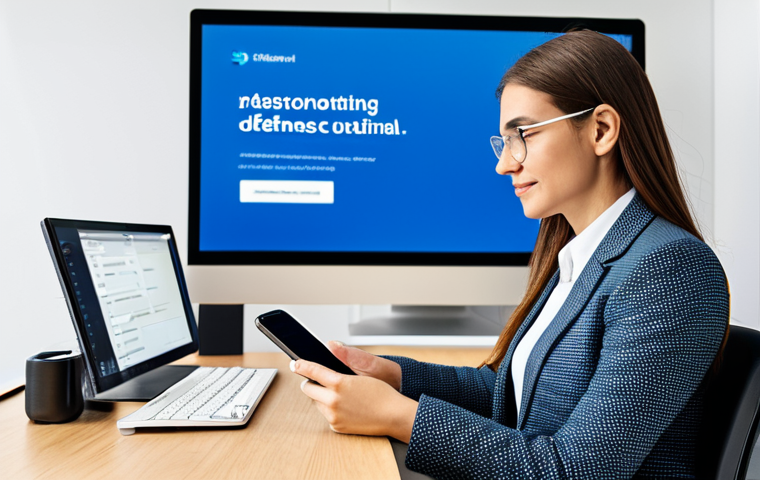You know, it’s wild to think about how much we rely on email these days, isn’t it? From urgent business communications to deeply personal messages, it’s just woven into the very fabric of our daily lives.
But here’s the kicker: this incredible convenience often blinds us to the sheer vulnerability it introduces into our digital world. I’ve personally witnessed the devastating fallout from what seemed like a harmless click – a company’s entire network held hostage by ransomware, all stemming from a single, well-crafted phishing email.
It’s no longer about obvious spelling mistakes or sketchy Nigerian princes; these threats are constantly morphing, now leveraging sophisticated AI to create hyper-realistic deepfakes and shockingly convincing business email compromise (BEC) schemes.
My own experience in the field tells me that the future of information security isn’t just about stronger firewalls, but about outsmarting these incredibly adaptive, AI-powered adversaries and embracing a proactive, zero-trust approach to every single inbox.
The digital battlefield is constantly evolving, and keeping your email secure is literally like playing high-stakes chess. It truly feels like an endless race against time, where the stakes couldn’t be higher for everyone, from individuals to global corporations.
Let’s get the precise facts.
The Shifting Sands of Email Threats

It feels like just yesterday we were all laughing at those hilariously obvious “Nigerian Prince” scams, right? Well, let me tell you, those days are long gone.
The threat landscape in email security has evolved at an alarming, almost terrifying, pace. What I’ve personally witnessed over the past few years is a complete transformation from crude, easily detectable attempts to incredibly sophisticated, AI-driven attacks that can fool even the most vigilant among us.
It’s not just about simple phishing links anymore; we’re talking about deepfake audio in voice phishing (vishing), AI-generated text that perfectly mimics a colleague’s writing style in business email compromise (BEC) schemes, and ransomware variants that encrypt your entire digital life in seconds.
The sheer cunning involved in these new attacks is truly mind-boggling, and it often preys on our inherent trust and the speed at which we operate in our daily lives.
I’ve seen countless organizations, from small businesses to large enterprises, brought to their knees because one unsuspecting employee clicked on what looked like a legitimate invoice or an urgent message from their CEO.
The emotional toll, not just the financial, is something you simply cannot underestimate. It’s a constant arms race, and the adversaries are getting smarter, faster, and far more insidious with every passing day.
1. The Rise of AI-Powered Phishing and BEC
The era of poorly written phishing emails is unequivocally over. I’ve been analyzing these threats for years, and the sophistication now is truly a game-changer.
Cybercriminals are now leveraging generative AI models to craft emails that are virtually indistinguishable from legitimate communications. Imagine receiving an email from your “CFO” requesting an urgent wire transfer, and the language, tone, and even subtle quirks perfectly match their typical correspondence.
This isn’t coincidence; it’s calculated AI at work. They can analyze vast amounts of publicly available data, social media posts, and even leaked information to construct a hyper-personalized attack.
This makes traditional detection methods, which often rely on identifying grammatical errors or unusual phrasing, increasingly ineffective. The sheer volume of highly targeted, convincing attacks is overwhelming, and it requires a completely new defensive mindset.
It genuinely feels like we are battling ghosts, as the attackers leave very few discernible traces of their true intent.
2. Ransomware’s Evolving Grip and Data Exfiltration
Beyond simply locking up your files, modern ransomware gangs are adding a terrifying new layer to their extortion tactics: data exfiltration. I’ve seen this strategy become frighteningly common.
They don’t just encrypt your data; they steal it first. This means even if you have impeccable backups and can restore your systems, they still hold a powerful card: the threat of publicly leaking your sensitive information.
This “double extortion” method significantly increases the pressure on victims to pay the ransom. And it all too often starts with a cleverly disguised email containing a malicious link or attachment.
The psychological impact of knowing your confidential documents, customer data, or proprietary designs could be splashed across the dark web is immense, often leading companies to make difficult decisions that they would otherwise avoid.
It’s a truly chilling development that highlights the interconnectedness of all digital threats.
Beyond Passwords: Fortifying Your Digital Gates
While the threats are evolving, so too are our defenses, thankfully. Relying solely on a complex password, no matter how strong, is like trying to stop a hurricane with a single umbrella.
It’s simply not enough in today’s threat landscape. My own hands-on experience has repeatedly shown that a multi-layered approach is the only way to truly secure your email communications.
This isn’t just about implementing technical solutions; it’s about embedding a culture of security awareness and resilience throughout an organization and in our personal lives.
We need to think of our email accounts not just as mailboxes, but as gateways to our entire digital identity – our financial information, personal memories, professional networks, and sensitive data.
Protecting that gateway requires a robust, proactive strategy that goes far beyond simple login credentials. I feel a strong sense of urgency when I talk about this, because the consequences of inaction are so profoundly severe.
1. Multi-Factor Authentication (MFA) as a Non-Negotiable Standard
If there’s one piece of advice I could shout from the rooftops, it’s this: enable Multi-Factor Authentication (MFA) on *everything*, especially your email.
I’ve witnessed firsthand how MFA has thwarted countless attempted breaches. Even if a sophisticated phishing attack manages to steal your password, the attacker hits a brick wall at the second factor – whether it’s a code from an authenticator app, a fingerprint scan, or a hardware security key.
It’s a simple, yet incredibly effective, barrier that drastically reduces the chances of unauthorized access. I remember a particularly nasty credential stuffing attack targeting one of my clients; millions of stolen username/password pairs were being tested.
Thanks to MFA, not a single one of their accounts was compromised. It’s an extra step, yes, but that minor inconvenience pales in comparison to the nightmare of a compromised email account.
It’s the digital equivalent of deadbolting your front door after locking it.
2. Advanced Email Filters and Gateway Protections
Think of advanced email filters as your digital bouncers, standing guard at the entrance to your inbox. These aren’t your grandpa’s spam filters; modern solutions employ AI, machine learning, and behavioral analysis to detect and block even the most cunning threats.
They can identify malicious links hidden within seemingly benign text, analyze sender behavior for anomalies, and even spot deepfake indicators in real-time.
I’ve personally configured and fine-tuned these systems, and the difference they make is profound. They can quarantine suspicious emails before they even reach a user’s inbox, providing a crucial layer of defense.
It’s truly amazing to see how these technologies learn and adapt, continuously improving their ability to catch even the newest zero-day threats. This proactive filtering is absolutely essential in an environment where threats are constantly morphing.
The Human Element: Our Toughest Security Vulnerability
No matter how many firewalls you erect or how sophisticated your AI filters become, the uncomfortable truth is that humans remain the primary vulnerability in any security chain.
And I’m not pointing fingers, because I’ve been there, too – moments of distraction, urgency, or simple trust can lead to a critical lapse in judgment.
Cybercriminals know this instinctively, and they spend an enormous amount of time crafting attacks that exploit our psychology, not just our technical weaknesses.
It’s a disheartening reality that even with all the awareness training in the world, the sheer cleverness of social engineering can sometimes bypass our better judgment.
This is why cultivating a pervasive culture of security awareness and healthy skepticism isn’t just a suggestion; it’s an absolute necessity.
1. The Art of Social Engineering and Psychological Manipulation
I’ve spent countless hours dissecting social engineering schemes, and what strikes me most is their reliance on basic human emotions: fear, urgency, curiosity, and even greed.
A classic tactic I’ve seen used effectively is the “CEO fraud” or Business Email Compromise (BEC), where an attacker impersonates a senior executive to trick an employee into making a fraudulent payment.
They create a sense of urgency, often claiming a highly confidential transaction that needs to be handled immediately and discreetly. The target feels pressured to comply, fearing repercussions if they don’t.
Or consider the allure of a fake package delivery notification; our innate curiosity to know “what’s inside” often overrides caution. These aren’t technical hacks; they’re psychological masterstrokes, designed to bypass our rational thought processes.
It truly highlights that the battle for email security is as much about human behavior as it is about technology.
2. Continuous Security Awareness Training and Phishing Simulations
Given the human factor, ongoing education is non-negotiable. It’s not enough to have a once-a-year training session; security awareness needs to be a continuous, evolving process.
I advocate for regular, realistic phishing simulations – emails designed to mimic actual threats. When I’ve implemented these, the initial results can be disheartening, but the long-term impact is transformative.
Employees learn to spot red flags in a safe environment, and their vigilance improves dramatically over time. More importantly, it fosters a culture where reporting suspicious emails is encouraged, not feared.
I’ve found that gamification and making the training engaging rather than dull has a significant impact on retention and behavioral change. It needs to be more than just a checkbox exercise; it needs to genuinely empower individuals to be the first line of defense.
Leveraging AI: Friend or Foe in the Inbox Battle?
The very technology that fuels advanced cyber threats – Artificial Intelligence – also holds immense promise as a powerful tool for defense. It’s a fascinating paradox, isn’t it?
As an expert who works with these systems daily, I can tell you that AI and machine learning are revolutionizing how we detect, analyze, and respond to email-based attacks.
However, it’s not a silver bullet. The key lies in understanding how to harness AI’s capabilities effectively while acknowledging its limitations. It feels like we’re just scratching the surface of what’s possible, and the ethical considerations around AI’s use in security are also something we absolutely must grapple with.
1. AI for Proactive Threat Intelligence and Anomaly Detection
One of the most exciting applications of AI in email security is its ability to process vast amounts of data at speeds no human ever could. AI-powered systems can analyze global threat intelligence feeds, identify emerging attack patterns, and even predict potential future threats.
I’ve seen these systems flag anomalies in email traffic that would be completely invisible to human eyes – unusual sending times, slightly altered email addresses, or subtle deviations in an email’s metadata.
They can establish a baseline of “normal” email behavior for an organization or individual, and then immediately flag anything that deviates from that norm.
This proactive detection allows security teams to respond much faster, often before a widespread incident can occur. It’s truly like having a super-intelligent, tireless guard dog constantly watching your digital perimeter.
2. The Double-Edged Sword: AI’s Role in Generating and Detecting Threats
Here’s where it gets complicated: the same AI technologies that generate hyper-realistic phishing emails are also being used to detect them. It’s a continuous, high-stakes game of cat and mouse.
AI models can be trained to identify the characteristics of AI-generated text, deepfake audio patterns, and sophisticated social engineering narratives.
However, as defensive AI models improve, offensive AI models learn and adapt, creating new ways to bypass detection. It’s an ongoing arms race where innovation on one side quickly prompts innovation on the other.
This dynamic means that relying solely on AI to solve all our security problems is naive. It must be paired with human oversight, critical thinking, and continuous refinement.
My experience tells me that while AI is an indispensable tool, it will never entirely replace the need for human intuition and strategic thinking.
Proactive Defense: Building an Impenetrable Email Fortress
Given the relentless evolution of threats, a purely reactive stance on email security is a losing battle. You can’t just wait for the attack to happen and then try to clean up the mess.
My philosophy, honed through years of dealing with breaches, is that proactive defense is the only sustainable strategy. It’s about building resilience into every layer of your digital infrastructure, not just in your email, but it starts there because it’s often the most common entry point.
This comprehensive approach ensures that even if one layer fails, others are there to catch the threat. It genuinely feels like a marathon, not a sprint, where consistent effort pays off immensely.
1. Implementing Zero Trust Principles for Email Access
The “Zero Trust” model is gaining significant traction, and for very good reason. Instead of assuming trustworthiness within your network, it operates on the principle of “never trust, always verify.” For email, this means that every single access request, every link clicked, and every attachment opened is rigorously authenticated and authorized, regardless of whether it originates from inside or outside the network.
I’ve personally helped organizations transition to this model, and while it requires a significant cultural and technical shift, the security benefits are immense.
It minimizes the impact of a potential breach by segmenting access and ensuring that even if an attacker gains a foothold, their lateral movement is severely restricted.
It’s a tough standard to meet, but the peace of mind it offers is truly invaluable.
2. Regular Backups, Disaster Recovery, and Incident Response Planning
Even with the most robust proactive defenses, the reality is that no system is 100% impenetrable. This is where planning for the worst becomes paramount.
My personal mantra is: “Hope for the best, prepare for the worst.” Regular, isolated backups are your last line of defense against ransomware and data loss.
But backups alone aren’t enough; you need a well-defined disaster recovery plan that outlines how you will restore systems and data quickly and efficiently.
Crucially, an incident response plan for email security is a must. This plan should detail who does what, when, and how, in the event of a phishing attack, BEC scam, or ransomware infection.
I’ve seen organizations recover quickly because they had a plan, and others flounder because they didn’t. Practicing these plans through tabletop exercises is also incredibly beneficial.
Incident Response: When the Walls Come Down
Despite all our best efforts, sometimes an email-borne threat slips through. It’s an unfortunate reality, but it’s how you react in those critical moments that truly defines your resilience.
I’ve been on the front lines during countless breaches, and I can tell you that a swift, organized, and effective incident response is absolutely crucial.
Panicking or acting without a clear strategy can turn a manageable incident into a catastrophic one. It’s a high-stress situation, and having a predefined playbook makes all the difference in minimizing damage and ensuring a quicker recovery.
It really boils down to having a battle plan for when the unexpected inevitably happens.
1. Rapid Detection and Containment Strategies
The first 24-48 hours after a breach are often the most critical. This is why rapid detection is paramount. My experience shows that the quicker you identify a compromised email account or a phishing campaign, the faster you can contain it.
This means having logging and monitoring tools in place that can alert you to suspicious activity – unusual login locations, large data transfers, or high volumes of outgoing emails.
Once detected, immediate containment is key. This could involve isolating affected accounts, revoking access, or blocking malicious IP addresses. The goal is to prevent the threat from spreading further within your network or impacting other users.
It’s an intense race against time, and every second counts.
2. Post-Incident Analysis and Learning
After the dust settles and the immediate crisis is managed, the real work of learning begins. It’s not enough to simply “fix” the problem; you must understand *how* it happened and *why* your existing defenses failed.
I always advocate for a thorough post-incident analysis. This involves dissecting the attack vectors, identifying vulnerabilities, and reviewing the effectiveness of your response.
This isn’t about assigning blame, but about continuous improvement. What lessons can be learned? What changes need to be made to prevent similar incidents in the future?
This iterative process of learning and adapting is what truly strengthens your long-term security posture. Every incident, no matter how painful, offers an invaluable opportunity to become more resilient.
| Threat Type | Common Characteristics | Impact on Individuals/Businesses | Prevention Strategies |
|---|---|---|---|
| Phishing (Standard) | Generic sender, suspicious links, urgency, grammar errors (less common now) | Credential theft, malware infection, financial loss | MFA, email filtering, user awareness training, link scanning |
| Spear Phishing | Personalized message, specific details about target, seemingly legitimate source | High success rate for credential theft, sensitive data compromise | Advanced email filters, rigorous sender verification, skepticism, internal verification processes |
| Business Email Compromise (BEC) | Impersonation of executive/vendor, urgent financial request (wire transfer, invoice payment), no malicious links/attachments usually | Significant financial fraud, reputational damage, legal consequences | Multi-factor authentication for financial transactions, strict payment verification protocols, executive awareness training, verbal confirmation for unusual requests |
| Ransomware (via Email) | Malicious attachments (executables, macros), deceptive links leading to drive-by downloads | Data encryption, network paralysis, data exfiltration, large ransom demands | Robust endpoint protection, regular data backups (offline), email sandbox analysis, user training on suspicious attachments, network segmentation |
| Deepfake Phishing (Vishing/Smishing) | AI-generated voice/video impersonation, highly convincing, social engineering via phone/SMS | Sophisticated financial fraud, intellectual property theft, identity theft | Verifying identities through a separate, known channel (e.g., calling back on a known number), skepticism of unusual requests, internal verification protocols |
Wrapping Up
As we’ve explored, the landscape of email security is constantly shifting, demanding our vigilance and adaptability. What I hope you take away from this isn’t a sense of dread, but rather empowerment.
While the threats are increasingly sophisticated, our defenses are evolving too, driven by powerful technologies and, more importantly, by human ingenuity and awareness.
My personal journey through countless security incidents has reinforced one undeniable truth: a multi-layered approach, combining cutting-edge tech with an educated human element, is our strongest shield.
Let’s commit to making our inboxes not just mailboxes, but fortresses.
Handy Tips for a Safer Inbox
1. Always Verify, Especially Financial Requests: If you receive an urgent email, especially from a “superior” or “vendor” requesting a wire transfer or unusual payment, never rely solely on the email itself. Pick up the phone and call the person directly using a *known* number, not one provided in the email. This simple step has saved countless organizations from significant financial losses.
2. Enable Multi-Factor Authentication (MFA) Everywhere: I cannot stress this enough. MFA adds a crucial second layer of security to your accounts. Even if your password is compromised, an attacker can’t get in without that second factor, whether it’s a code from your phone or a hardware key. It’s your digital deadbolt.
3. Think Before You Click (or Download): This is a timeless rule, and it’s more relevant than ever. Scrutinize links before clicking by hovering over them to reveal the actual URL. Be highly suspicious of unexpected attachments, even from people you know. When in doubt, delete it or forward it to your IT department for verification.
4. Keep Software Updated and Use Reputable Antivirus: Many email-borne threats exploit vulnerabilities in outdated software. Regular updates patch these security holes. Combine this with a robust, regularly updated antivirus and endpoint detection solution on your devices. It’s your basic digital hygiene.
5. Beware of Information Overload and Urgency: Cybercriminals often leverage our busy lives and our desire to be efficient. Emails designed to create a sense of urgency, fear, or intense curiosity are red flags. Take a deep breath, step back, and critically evaluate the message before acting. It’s okay to pause and question; in fact, it’s essential.
Key Takeaways
Email threats are evolving rapidly, with AI enhancing their sophistication. Proactive, multi-layered defenses are essential, combining advanced technology like AI-powered filters and Multi-Factor Authentication with a strong emphasis on the human element through continuous security awareness training.
Incident response planning is crucial for minimizing damage when a breach occurs, and learning from every incident strengthens long-term security.
Frequently Asked Questions (FAQ) 📖
Q: Okay, so the introduction paints a pretty grim picture about
A: I making email threats super sophisticated. From your perspective, how exactly is AI actively transforming these scams like phishing and BEC, making them so much harder to spot than the old ‘Nigerian prince’ days?
A1: You know, it’s not just a subtle shift; it’s a seismic one. We used to look for clunky grammar or bizarre requests, right? Now, with AI, that’s almost quaint.
I’ve personally seen BEC schemes where the email tone, vocabulary, and even the nuances of a CEO’s typical communication style were eerily perfect, thanks to AI analyzing their past communications.
Imagine getting an email from your boss, asking for an urgent wire transfer, and it sounds exactly like them, not just generic corporate speak. That’s AI’s power – crafting hyper-personalized lures.
Then you’ve got deepfakes, which are just chilling. While not purely email-based, they’re often initiated by an email that leads you to a fake video call, where you’re ‘talking’ to a meticulously crafted, AI-generated version of someone you know.
It’s no longer about tricking you with a bad link; it’s about tricking your mind into believing an impossible reality. It exploits trust on a whole new level.
Q: The idea of a ‘zero-trust approach’ for email sounds incredibly important, but honestly, for most of us, it feels a bit abstract. Can you break it down? What does ‘zero-trust’ truly look like when you’re just trying to manage your daily inbox, whether for work or personal stuff?
A: That’s a brilliant question, because ‘zero-trust’ isn’t just an IT buzzword; it’s a fundamental mindset shift, and it’s actually tougher than it sounds.
For your daily inbox, it means approaching every single email with inherent skepticism, no matter who it says it’s from. Think of it like this: if your closest friend emails you asking for sensitive information or a quick favor that seems even slightly off, your immediate instinct should be to verify it through an alternative, known channel – a quick phone call, a text message, anything but replying to that email.
I’ve seen countless instances where people fell for what looked like a legitimate internal email because they trusted the sender’s name. Zero-trust means assuming that even if the sender looks legitimate, their account could be compromised.
It’s about verifying credentials for every link, second-guessing every attachment, and essentially treating every incoming message as a potential threat until proven otherwise.
It’s a tough pill to swallow, requiring constant vigilance, but it’s the only way to play defense effectively in this new landscape.
Q: With the digital battlefield constantly evolving and stakes so high, as you mentioned, it can feel a bit overwhelming. If you had to boil it down, what’s the absolute most critical, immediate step both individuals and large corporations should be taking to fortify their email security against these increasingly intelligent,
A: I-powered adversaries? A3: Oh, if I had to pick just one thing, it’s not another piece of software or a fancier firewall, as crucial as those are. It’s relentlessly, continuously investing in human awareness and education.
Sounds almost too simple, doesn’t it? But here’s the reality: no matter how many layers of technical security you stack up, the human element remains the most exploited vulnerability.
These AI-powered threats are designed to bypass technology by directly targeting our psychology, our trust, our busy schedules. I’ve witnessed countless companies spend millions on perimeter defense, only to be utterly crippled because one employee, just one, clicked a link they shouldn’t have.
For individuals, it’s about making that gut-check a reflex. For corporations, it’s about making security awareness training so engaging and realistic that it actually sticks, moving beyond the boring annual checkbox exercise.
It needs to be constant, updated with the latest tactics, and stress-tested with realistic simulations. Empowering every single person to be a vigilant human firewall is, hands down, the most potent defense we have in this high-stakes chess match.
📚 References
Wikipedia Encyclopedia
구글 검색 결과
구글 검색 결과
구글 검색 결과
구글 검색 결과
구글 검색 결과



